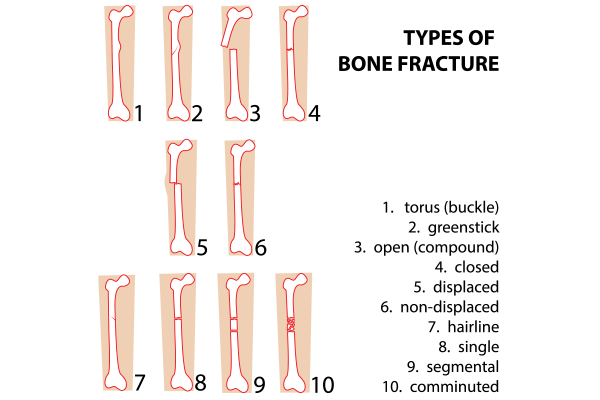
Hairline fractures, also known as stress fractures, are tiny cracks in a bone caused by repetitive force or overuse, rather than a single traumatic event. They often develop over time and are common in weight-bearing bones like the foot, ankle, and shin.
Though small, these fractures can cause significant discomfort and, if left untreated, may worsen over time. Recognizing symptoms early and seeking prompt treatment is crucial for full recovery.
In this blog, we focus on hairline fractures—their types, symptoms, treatments, and hairline fracture healing time—followed by a brief overview of other major fracture types and their management.
Synopsis
Top Types of Hairline Fractures: Symptoms, Treatment & Healing Time
1. Hairline Fracture in the Foot (Stress Fracture in Metatarsals)
One of the most common types, especially in runners and athletes. Usually occurs in the metatarsal bones.
-
Symptoms: Mild but persistent pain, swelling, tenderness, and difficulty bearing weight.
-
Treatment: Rest, ice, elevation, and protective footwear. In some cases, a boot or crutches may be needed.
-
Healing Time: 6–8 weeks
2. Hairline Fracture in the Ankle (Microscopic Cracks from Twisting or Overuse)
Often caused by repetitive strain or sudden twisting motions.
-
Symptoms: Localised pain, swelling, stiffness, and pain when putting weight on the ankle.
-
Treatment: Immobilisation with a brace or cast, rest, and gradual rehabilitation.
-
Healing Time: 6–8 weeks
3. Hairline Fracture in the Wrist (Tiny Cracks from Impact or Overuse)
Common from overuse or falls on an outstretched hand.
-
Symptoms: Tenderness, swelling, reduced range of motion, and dull pain.
-
Treatment: Splinting or casting, with limited hand use.
-
Healing Time: 6–8 weeks
4. Hairline Fracture in the Shin (Stress-Induced Tibial Fracture)
Frequently seen in athletes due to running and jumping activities.
-
Symptoms: Deep ache, worsening with activity, and possible visible swelling.
-
Treatment: Rest, icing, avoiding impact activities, and gradual reintroduction of physical activity.
-
Healing Time: 8–10 weeks
5. Hairline Fracture in the Hip (Microfractures in Elderly or Osteoporotic Patients)
More common in older adults or those with low bone density.
-
Symptoms: Groin or thigh pain, limping, and pain during walking.
-
Treatment: Rest, pain management, assistive walking devices, and sometimes surgery.
-
Healing Time: 8–12 weeks
More Reads: Signs a Broken Bone Is Not Healing Properly & What to Do
Other Common Types of Bone Fractures
-
Greenstick Fracture: Partial fracture common in children where the bone bends and cracks but doesn’t break completely.
-
Comminuted Fracture: Bone is broken into several pieces, often requiring surgery.
-
Open vs. Closed Fracture:
-
Open Fracture: Bone breaks through the skin.
-
Closed Fracture: Bone breaks, but skin remains intact
-
- Avulsion Fracture: A small chunk of bone attached to a tendon or ligament gets pulled away.
More Reads: All About Arthritis: Symptoms, Treatment, Myths And Facts
How Are Hairline Fractures (Subtle Bone Cracks) Diagnosed?
Diagnosis typically involves:
-
Physical examination
-
X-ray (may not detect early-stage hairline fractures)
-
MRI or bone scan (for more detailed imaging)

Treatment Options for Fractures
| Fracture Type | Treatment Options |
|
Rest, immobilisation, protective gear, gradual return to activity |
|
Splint or cast |
|
Surgery with metal supports |
|
Surgery, antibiotics, wound care |
|
Physical therapy, rest, sometimes surgery |
Recovery and Healing Tips for Hairline Fractures
-
Healing Time:
-
Hairline fractures (including foot, ankle, and wrist): 6–8 weeks
-
Greenstick: 4–6 weeks
-
Comminuted: 3–6 months
-
Stress: 6–8 weeks
-
-
Recovery Tips:
-
Maintain a nutrient-rich diet (calcium, vitamin D, protein)
-
Avoid weight-bearing activities
-
Follow the doctor's advice and therapy plans
-
When to See a Doctor
If you experience:
-
Ongoing pain
-
Swelling that doesn't subside
-
Difficulty in movement
-
Any deformity after injury
Seek medical attention immediately. Delaying treatment can lead to long-term complications.
Conclusion
At Manipal Hospital Patiala, our expert orthopaedic team uses advanced imaging and personalized treatment plans to help you recover from all kinds of fractures—including tricky hairline fractures. From consultation to full rehabilitation, we offer the care and guidance you need to heal stronger and faster.
Book your appointment today for accurate diagnosis and comprehensive fracture care!
FAQ's
Persistent pain and swelling in a specific area after repetitive stress may indicate a hairline fracture (tiny crack in the bone). Imaging tests like an MRI help confirm the diagnosis.
It is not advisable. Walking can worsen the condition. Use protective footwear and rest to prevent further damage to your hairline fracture in your foot.
Typically, hair fractures in ankle injuries take 6–8 weeks depending on severity and care.
Proper rest, nutrition, avoiding strain, and following your doctor’s advice are key to minimizing hairline fracture healing time.
Not necessarily. Some hairline fracture wrist injuries may heal with splints or protective boots depending on the location and severity.



















 6 Min Read
6 Min Read
















